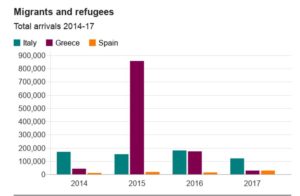Europe’s migration crisis – the latest trends
 Migration continues to be a defining political and social issue in Europe but the rhetoric and hyperbole coming from some of Europe’s populist leaders are not backed up by the latest numbers and trends in the flow of people into the continent.
Migration continues to be a defining political and social issue in Europe but the rhetoric and hyperbole coming from some of Europe’s populist leaders are not backed up by the latest numbers and trends in the flow of people into the continent.
Mainland Spain has for the first time become the main entry point for migrants arriving in Europe from Africa by sea while the overall number of migrants has fallen sharply in the past year, according to UNHCR data.
Italy’s decision in June not to accept the rescue vessel Aquarius with more than 600 migrants on board attracted widespread criticism and also shifted the moral argument.
Meanwhile, the issue of border controls for migrants threatened to break the German coalition government and the Chancellorship of Angela Merkel.
At the peak of migration into Europe in 2015, 1,015,078 arrivals were recorded. More than 800,000 of them were trafficked via the sea from Turkey to Greece, and the majority of them continued to travel through Europe to reach Germany and Sweden.
Since 2015, the number of refugees and migrants arriving in Greece has fallen dramatically, after the EU and Turkey signed an agreement to send migrants who do not apply for asylum, or whose claim was rejected, back to Turkey.
While the number of arrivals has dropped in Greece, the number of people arriving in Italy has changed little on the 2015 levels.
In 2016 and 2017, 180,000 and 119,000 arrived respectively, smuggled by traffickers from North Africa and rescued at sea. In 2017, Italy received 67 per cent of the EU’s migrant arrivals.
But since January this year, the number of arrivals in Italy has greatly reduced, with 17,000 arriving by mid-July 2018.
In the same period, Spain received the highest number of migrants and refugees – more than 20,000 – the majority of them by sea and around 2,800 by land to Ceuta and Melilla, two Spanish enclaves in North Africa.
The UN refugee agency (UNHCR) says that routes used by human traffickers are constantly changing and are dependent on a number of factors, but the drop in numbers reaching Italy is attributed mainly to its close co-operation with the Libyan coastguard.
A total of 14,500 have arrived in Greece so far this year, bringing the total number of arrivals in the EU in 2018 to just over 49,000.
Syria is still the most common country of origin of those arriving in Greece. Iraqis, Afghans, Palestinians, Congolese and Iranians make up many of the other arrivals.
In Italy and Spain, arrivals from African countries top the list. In Italy, the most common country of origin is Tunisia, followed by Eritrea, Nigeria, Ivory Coast and Sudan. Spain received the largest number of migrants and refugees from Syria, Guinea, Mali, Morocco, Ivory Coast and a number of other Sub-Saharan African countries.
One worrying statistic shows that crossing the Mediterranean has become deadlier as the number of deaths, as a proportion of the number of people who actually manage to reach the EU, is rising.
In 2015, there was one death in every 269 arrivals recorded. In 2016, this went up to one death in 72 arrivals and in 2017 to one in 57 arrivals.
Based on figures to mid-July 2018, the deadliest year so far has been this year, with one death for every 34 people who arrived in the EU.
The top countries by origin of asylum seekers in the EU since 2014 are Syria, Iraq, Afghanistan, Nigeria and Pakistan, all countries with recent or ongoing conflicts.
Between 2014 and 2017, a total of more than 919,000 Syrians applied for asylum in the EU.
Asylum seekers from Eritrea, Bangladesh, Somalia, Iran and a number of Sub-Saharan countries are among the top 10 countries of origin of those who have been applying for asylum in the EU since 2014.
The top country for successful asylum applications is Germany, where more than 60,000 were granted asylum in 2017, followed by France, the UK, Sweden and Austria.
Laurie Nowell
AMES Australia Senior Journalist












